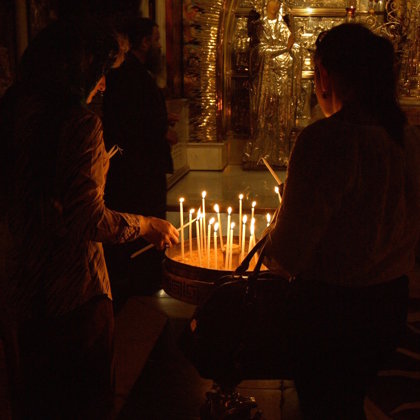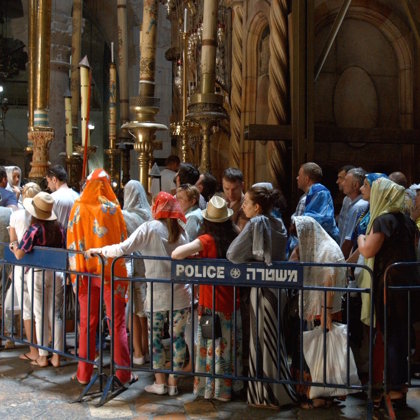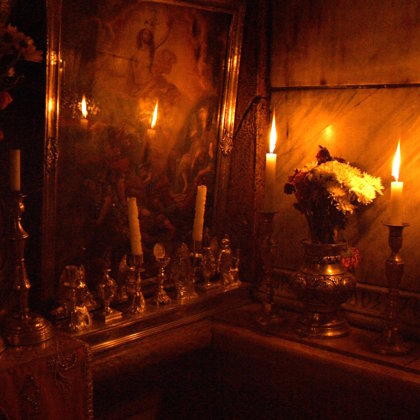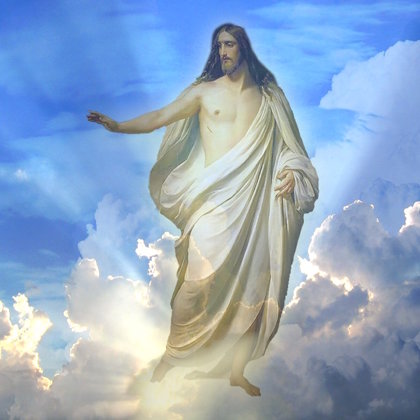Today the Via Dolorosa runs along several streets with 14 stations, from one of the two possible official residences of Pilate, the Antonia fortress, or its sparse remains, west of the Lion's or Stephan's Gate through the old town up to the Church of the Holy Sepulchre, which stands at the place where Jesus is said to have been buried.
It includes several old town streets: in the eastern part along the Lion's Gate Street; then via the Ṭariq al-Wad (Al-Wad-Street), which leads from the Damascus Gate to the Western Wall and to the Dung Gate; finally, in its western part, it leads through winding alleys, partly in the form of a stairway, partly covered with arcades. All churches and chapels that mark the stations outside the Church of the Holy Sepulchre are Catholic and belong either to the Roman Catholic churches or to one of the churches united with Rome.
The shrine of Jesus' burial and resurrection is located in a chapel built exclusively for this shrine and is the center point of the Sepulchre Church.
*
Die Via Dolorosa führt heute über mehrere Straßen an 14 Stationen entlang, von einem der zwei denkbaren Amtssitze des Pilatus, der Antoniafestung, beziehungsweise deren spärlichen Überresten, westlich vom Löwen- oder Stephanstor durch die Altstadt bis hin zur Grabeskirche, die an jenem Ort steht, wo Jesus ins Grab gelegt worden sein soll.
Sie bezieht dabei mehrere Altstadtstraßen ein: im östlichen Teil entlang der Löwentorstraße; anschließend über die Ṭariq al-Wad („Talstraße“), die vom Damaskustor zur Klagemauer und zum Dungtor führt; schließlich führt sie in ihrem westlichen Teil durch verwinkelte Gässchen, teilweise in Form einer Treppengasse, teilweise mit Bogengängen überdeckt. Sämtliche Kirchen und Kapellen, die die Stationen außerhalb der Grabeskirche markieren, sind katholisch und gehören entweder der römisch-katholischen oder einer der mit Rom verbundenen Kirchen an.
Die Stätte von Jesus’ Begräbnis und Auferstehung befindet sich in einer eigenen Kapelle und bildet das Zentrum der ganzen Grabeskirche.
*
La Vía Dolorosa hoy en día discurre por varias calles a lo largo de 14 estaciones, desde una de las dos residencias de la magistratura de Pilatos, la Fortaleza Antonia, respetivamente sus escasos restos, al oeste de la Puerta del León o la Puerta de San Esteban a través de del casco antiguo hasta la Iglesia del Santo Sepulcro, que se encuentra en ese lugar, donde se dice que Jesús fue colocado en la tumba.
Ella incluye varias calles del casco antiguo: en la parte oriental a lo largo de la calle de la Puerta del León; a continuación a través de Ṭariq al-Wad (“calle del valle”), que conduce desde la Puerta de Damasco hasta el Muro de los Lamentos y la Puerta del Estiércol; finalmente, en su parte occidental, discurre a través de callejones angulados, en parte en forma de callejón de escalera, en parte cubiertos de arcos. Todas las iglesias y capillas que marcan las estaciones fuera de la Iglesia del Santo Sepulcro son católicas y pertenecen a la Iglesia Católica Romana o a una de las iglesias asociadas con Roma.
El lugar del entierro y resurrección de Jesús se encuentra en su propia capilla y forma el centro de toda la Iglesia del Santo Sepulcro.
*
Oggi la Via Dolorosa si estende lungo diverse strade con 14 stazioni, partendo da una delle due possibili residenze ufficiali di Pilato, la Fortezza Antonia, o i suoi scarsi resti, a ovest alla Porta dei Leoni, oppure dalla porta di Santo Stefano, attraverso il centro storico sino alla Chiesa del Santo Sepolcro, collocandosi nel luogo in cui si narra sia stato sepolto Gesù.
Il percorso ingloba diverse strade del centro storico: nella parte orientale lungo la via della Porta dei Leoni; passando attraverso la via Ṭariq al-Wad (Al-Wad-Street) che conduce dalla Porta di Damasco al Muro del Pianto e alla Porta del Letame; passando infine, nella parte occidentale, attraverso vicoli tortuosi, in parte a forma di scala ed in parte coperti da portici. Tutte le Chiese e le cappelle che indicano le stazioni all'esterno della Chiesa del Santo Sepolcro sono cattoliche e appartengono o al Cattolicesimo romano o a una delle Chiese associate a Roma.
Il santuario della Sepoltura e Resurrezione di Gesù sono collocati in una cappella propria formando il punto centrale della Chiesa del Santo Sepolcro.



